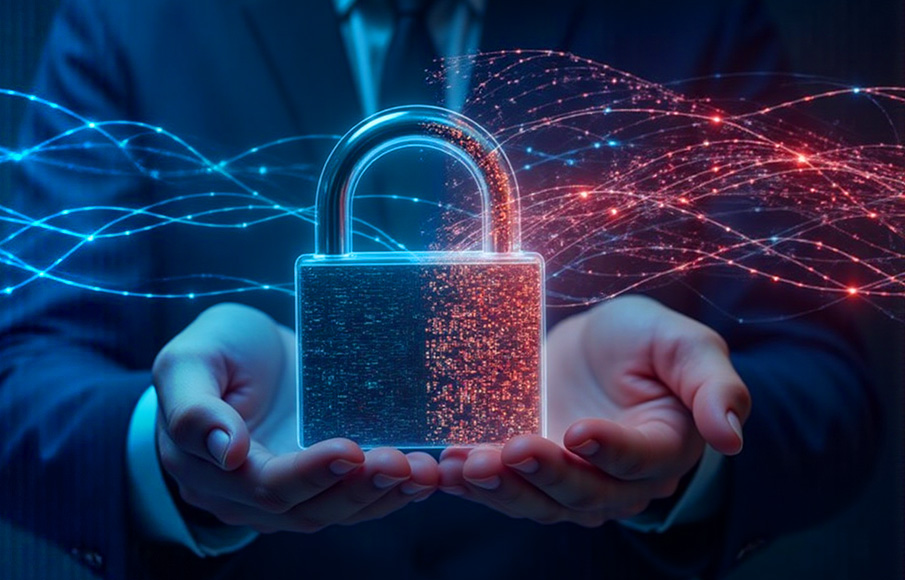Quantum Key Distribution (QKD) Explained for Businesses (2025)
- 15 November 2024

Quantum Key Distribution (QKD) and quantum cryptography (PQC) are becoming increasingly vital in the cybersecurity field. The global QKD market is expected to witness a CAGR of 34.0% during the forecast period from 2023 to 2029, and this is due to its role as a theoretically unhackable encryption method.
As the next major advancement in quantum cryptography technology, the QKD system offers unparalleled security by making use of the laws of quantum physics. It makes use of photon properties, which are completely non-negotiable, allowing it to serve as an excellent line of defence against the growing threat of Quantum Computers in hacking. It offers next-level data security that can significantly enhance protection for sensitive communications and transactions.
This innovative technology is already being incorporated into network solutions, such as those provided by SPTel, to ensure robust and secure information exchange in an increasingly digital world.
What exactly is Quantum Key Distribution?

Quantum Key Distribution (QKD) is a sophisticated method of secure communication that leverages the principles of quantum mechanics. It creates a pair of cryptographic quantum keys between two parties and prevents unauthorised individuals from accessing the information. This is achieved through the use of light particles (photons) to generate a shared and trusted key. This key is then used to decrypt information.
An impressive feature of Quantum Key Distribution Technology is its ability to detect disturbances in the photons during the transmission process. When a disturbance is identified, the system generates a new set of keys, thereby ensuring continuous security in the communication process.
Utilising the laws of physics, QKD systems remotely generate a secure, shared, and secret key. The system is capable of detecting and remedying potential breaches in security by regenerating this key whenever there are potential breaches. This level of protection is unparalleled in the cybersecurity domain, making QKD an indispensable tool for safeguarding sensitive information.
Quantum Key Distribution Explained: How Does It Work?

QKD relies on the principles of quantum mechanics when creating symmetric encryption keys. The method revolves around transmitting millions of light particles, known as photons, through a fibre optic cable. These photons can exist concurrently in both a 0 and 1 state, unlike binary data, which is one of the unique properties of quantum particles. Upon receiving the photons, the sender and receiver compare their information on the photon forms. The matched photons are used to create a secure encryption key. This key can then be utilised to encrypt data and sensitive information shared between the two parties.
Due to the nature of photons, it is impossible for eavesdroppers to observe them without being detected, or to replicate the key exactly. Photons’ properties physically change when observed, making any and all interference immediately obvious. A new set of keys is then generated, ensuring security between the sender and recipient.
Quantum Key Distribution differs from traditional encryption methods in several aspects. While conventional encryption relies on mathematical complexities that can be eventually broken with powerful computational resources, QKD harnesses the inherent unpredictability of quantum mechanics to offer a theoretically unhackable security solution. The keying material generated by QKD can be utilised in symmetric key cryptographic algorithms to enhance integrity and authentication.
Benefits of Quantum Key Distribution in Network Security

Commercial QKD systems offer several major advantages to customers:
Unconditional Security: Classical cryptographic methods rely on computational difficulty, such as numbers that would take too much computational power for modern computers to decode. However, with the advent of quantum computers, this difficulty can soon be overcome. QKD security claims are based on the fundamental laws of physics. This means that, even with unlimited computational power, an eavesdropper cannot breach the security, providing theoretical unconditional security.
Future-Proof: As quantum computing continues to develop, they pose a threat to many existing classical cryptographic methods, which may become obsolete in the face of such technological advancements. QKD, on the other hand, is resistant to these potential threats, and becoming an early adopter means that your networks are made secure even in the far future.
Robust Encryption: In addition to its enhanced security features, QKD also promotes robust encryption in data transmissions. The keys generated through QKD are used for one-time encryption, meaning that after exchanging encryption keys, both parties must regenerate a new set of keys. This single-use nature of the keys not only strengthens the encryption but also minimises the risk of key reuse or theft.
Overall, the integration of QKD in network security is an increasingly essential solution for clients seeking top-notch cryptographic security for their systems. By leveraging the principles of quantum mechanics, QKD offers major benefits that will extend far into an organisation’s future.
Quantum Key Distribution Solutions by SPTel

Singapore has recently announced the launch of the National Quantum-Safe Network Plus (NQSN+), an initiative aimed at providing quantum-safe communications across the country. The NQSN+ supports network operators in deploying QKD technology and has paved the way for companies such as SPTel to explore and develop QKD solutions.
As an established telecommunications provider, we recognise the importance of secure digital communications. We have partnered with SpeQtral, Toshiba and ST Engineering to successfully trial the first Quantum-Secure Network in Southeast Asia on our diverse, ultra-low latency fibre network, utilising ST Engineering’s quantum-enabled encryptors and Toshiba Digital Solutions’ Quantum Key Distribution system.
Businesses can work with us to integrate these quantum-safe solutions into their own data management, for unparalleled security of critical information.
QKD-as-a-Service (Dedicated)
One of the ways we can help implement quantum communications involves placing QKD devices at customer premises. QKD networks frequently necessitate specialised infrastructure, so our approach ensures that professional equipment remains secure and safe within the customer’s premises, away from any potential vulnerabilities related to hardware and engineering. Furthermore, since the secret keys are generated from equipment located on customer premises, an additional layer of end-to-end data security is established. Customers can determine their own key rate requirements, allowing for increased encryption security.
Quantum-Secure Data Centre Interconnect (Shared)
Another implementation method is via SPTel’s DCI network, which enables quantum-secure DWDM links between data centres. Instead of placing equipment on customer premises, customers can subscribe to SPTel’s QKD-enabled high bandwidth DCI connectivity service. Quantum-Secure DCI can be particularly advantageous for a wide range of industries, such as finance, healthcare, and government organisations, where data protection is paramount. By adopting a QKD-enabled service, these entities can leverage on the powerful principles of quantum physics to safeguard their sensitive information against potential cyber threats and eavesdropping.
The Role of Quantum Key Distribution in Future Communications

Quantum Key Distribution is emerging as an essential technology in secure communications, with the power to circumvent even the strongest theoretical hacking tools. The mature implementation of quantum mechanics helps to address security concerns for encryption technologies, as these devices become more and more prevalent. QKD’s benefits are supplemented by unchanging laws of physics, and this unconditional security makes it the ultimate solution in data protection for the foreseeable future.
SPTel is well-positioned to provide governments and enterprises with quantum-resistant cryptography with our diverse quantum safe networks, ultra-low latency network and secure edge nodes that are trusted locations for hosting QKD solutions. To explore more about our offerings, get in touch with our expert team.












